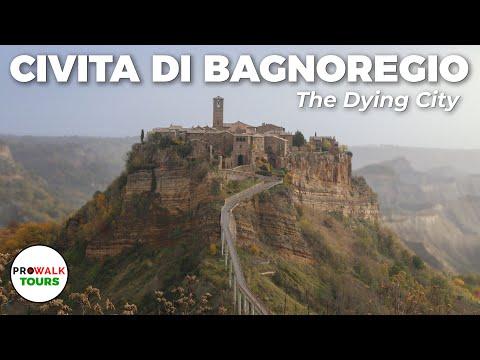The day I arrived at Civita di Bagnoregio, I could hardly contain my excitement. This ancient town, often referred to as “The Dying City,” held a mystery that beckoned to me like a whisper from the past. As I approached, the town’s silhouette emerged against the horizon, perched precariously atop a hill in the Italian region of Lazio. The sight was both captivating and melancholic, a testament to its enduring charm despite its fragility.
I began my walking tour at the edge of the bridge that connected Civita di Bagnoregio to the surrounding world. The bridge, a pedestrian pathway suspended over a deep chasm, seemed to float in the air. As I crossed it, I felt as if I was stepping into a different era, with each step echoing the footsteps of those who had walked this path centuries before me.
Once inside the town’s ancient walls, I was struck by the narrow, winding streets that wove their way through Civita di Bagnoregio. The buildings, made of tufa stone, were weathered by time but still stood proudly. Their earthy colors, ranging from golden yellows to muted grays, seemed to absorb the sunlight and transform it into a warm, soft glow. It was as if the town itself was exuding a quiet resilience, determined to remain beautiful in the face of the inevitable erosion.
My tour guide, an elderly local with a passion for history, began to explain the town’s origins. Civita di Bagnoregio was founded by the Etruscans over two thousand years ago and later inhabited by the Romans. Its strategic location atop a hill provided protection from invaders and offered breathtaking views of the surrounding countryside. However, this same location also made it vulnerable to natural forces. The soft tufa rock that gave the town its unique appearance was slowly being eroded by wind and rain. This erosion, coupled with the risk of landslides, has led to the town’s nickname, “The Dying City.”
As we wandered through the town, I couldn’t help but marvel at the contrast between its ancient allure and the modern challenges it faced. Despite its beauty, there were visible signs of decay. Some buildings were propped up by wooden supports, and a few had crumbled into the chasm below. Yet, there was a sense of resilience among the townsfolk. Many were involved in restoration projects, working tirelessly to preserve the city’s historical and cultural heritage.
One of the highlights of the tour was visiting the Church of San Donato, the main church in Civita di Bagnoregio. Its interior was a captivating mix of art and history, with frescoes that told stories of saints and miracles. The church, though modest in size, felt like a sanctuary from the outside world. I spent several moments simply sitting in the pews, reflecting on the town’s rich past and the delicate balance between preservation and decline.
Our next stop was a small local café where we tasted traditional Italian pastries and coffee. The café owner, an amiable woman with a bright smile, shared stories of the town’s past and her own family’s connection to it. Her anecdotes painted a vivid picture of daily life in Civita di Bagnoregio through the decades. Listening to her, I felt a deep connection to the place, as if I was not just a visitor but a part of its ongoing story.
As the day drew to a close, the light began to soften, casting a golden hue over the town. The shadows lengthened, and the ancient streets took on a dreamlike quality. I wandered alone for a while, absorbing the serene beauty of the landscape. The view from the town’s edge was breathtaking. Below, the valley stretched out, dotted with vineyards and olive groves, while the fading sunlight illuminated the distant hills. It was a scene that felt both timeless and fragile, much like Civita di Bagnoregio itself.
I ended my tour with a sense of profound respect for this remarkable place. Civita di Bagnoregio, though facing the ultimate challenge of erosion and decay, stood as a testament to the enduring spirit of human creativity and resilience. The town’s beauty was not just in its architecture or its picturesque setting but in its ability to evoke a deep sense of wonder and reflection. As I left, I carried with me a piece of its history, a reminder of how even in the face of inevitable change, there is a quiet strength in holding on to what truly matters.
